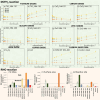A refined dose metric for nanotoxicology based on surface site reactivity for oxidative potential of engineered nanomaterials
- PMID: 40170906
- PMCID: PMC11956195
- DOI: 10.1039/d5na00104h
A refined dose metric for nanotoxicology based on surface site reactivity for oxidative potential of engineered nanomaterials
Abstract
The increasing production of engineered nanomaterials (ENMs) raises significant concerns about human and environmental exposure, making it essential to understand the mechanisms of their interaction with biological systems to manage the associated risks. To address this, we propose categorizing ENM reactivity using in chemico methodologies. Surface analysis through methanol chemisorption and temperature-programmed surface reaction allows for the determination of reactive surface sites, providing accurate estimates of effective ENM doses in toxicity studies. Additionally, antioxidant consumption assays (dithiothreitol, cysteine, and glutathione) and reactive oxygen species (ROS) generation assays (RNO and DCFH2-DA) are employed to rank the oxidative potential of ENM surface sites in a cell-free environment. Our study confirms the classification of ZnO NM-110, ZnO NM-111, CuO, and carbon black as highly oxidant ENMs, while TiO2 NM-101 and NM-105 exhibit low oxidative potential due to their acidic surface sites. In contrast, CeO2 NM-211 and NM-212 demonstrate redox surface sites. SiO2 nanomaterials (NM-200 and NM-201) are shown to be inert, with low oxidation rates and minimal reactive surface density, despite their high surface area. Quantifying reactive surface sites offers a refined dose metric for assessing ENM toxicity, advancing safe-by-design nanomaterial development.
This journal is © The Royal Society of Chemistry.
Conflict of interest statement
The authors declare no competing financial interest.
Figures




Similar articles
-
In chemico methodology for engineered nanomaterial categorization according to number, nature and oxidative potential of reactive surface sites.Environ Sci Nano. 2024 Jul 9;11(9):3744-3760. doi: 10.1039/d3en00810j. eCollection 2024 Sep 12. Environ Sci Nano. 2024. PMID: 39280766 Free PMC article.
-
A Safer Formulation Concept for Flame-Generated Engineered Nanomaterials.ACS Sustain Chem Eng. 2013 Jul 1;1(7):843-857. doi: 10.1021/sc300152f. ACS Sustain Chem Eng. 2013. PMID: 23961338 Free PMC article.
-
Ecological nanotoxicology: integrating nanomaterial hazard considerations across the subcellular, population, community, and ecosystems levels.Acc Chem Res. 2013 Mar 19;46(3):813-22. doi: 10.1021/ar300069t. Epub 2012 Oct 5. Acc Chem Res. 2013. PMID: 23039211
-
Ecophysiological perspectives on engineered nanomaterial toxicity in fish and crustaceans.Comp Biochem Physiol C Toxicol Pharmacol. 2017 Mar;193:30-41. doi: 10.1016/j.cbpc.2016.12.007. Epub 2016 Dec 23. Comp Biochem Physiol C Toxicol Pharmacol. 2017. PMID: 28017784 Review.
-
Building the Bridge From Aquatic Nanotoxicology to Safety by Design Silver Nanoparticles.Front Bioeng Biotechnol. 2022 Mar 8;10:836742. doi: 10.3389/fbioe.2022.836742. eCollection 2022. Front Bioeng Biotechnol. 2022. PMID: 35350188 Free PMC article. Review.
Cited by
-
Acute Dermatotoxicity of Green-Synthesized Silver Nanoparticles (AgNPs) in Zebrafish Epidermis.Toxics. 2025 Jul 15;13(7):592. doi: 10.3390/toxics13070592. Toxics. 2025. PMID: 40711036 Free PMC article.
References
-
- Khan I. Saeed K. Khan I. Nanoparticles: properties, applications and toxicities. Arabian J. Chem. 2019;12(7):908–931. doi: 10.1016/j.arabjc.2017.05.011. - DOI
-
- Kinnear C. Moore T. L. Rodriguez-Lorenzo L. Rothen-Rutishauser B. Petri-Fink A. Form Follows Function: Nanoparticle Shape and Its Implications for Nanomedicine. Chem. Rev. 2017;117(17):11476–11521. doi: 10.1021/acs.chemrev.7b00194. https://dx.doi.org/10.1021/acs.chemrev.7b00194 - DOI - DOI - PubMed
-
- Bañares M. A. Haase A. Tran L. et al., CompNanoTox2015: novel perspectives from a European conference on computational nanotoxicology on predictive nanotoxicology. Nanotoxicology. 2017;11(7):839–845. doi: 10.1080/17435390.2017.1371351. https://dx.doi.org/10.1080/17435390.2017.1371351 - DOI - DOI - PubMed
-
- Polo-Garzon F. Bao Z. Zhang X. Huang W. Wu Z. Surface Reconstructions of Metal Oxides and the Consequences on Catalytic Chemistry. ACS Catal. 2019;9(6):5692–5707. doi: 10.1021/acscatal.9b01097. https://dx.doi.org/10.1021/acscatal.9b01097 - DOI - DOI
-
- Wu Z. Mann A. K. P. Li M. Overbury S. H. Spectroscopic investigation of surface dependent acid base property of ceria nanoshapes. J. Phys. Chem. C. 2015;119(13):7340–7350. doi: 10.1021/acs.jpcc.5b00859. https://dx.doi.org/10.1021/ACS.JPCC.5B00859 - DOI - DOI
LinkOut - more resources
Full Text Sources

